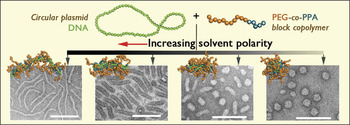The shapes of nanoparticles can play important roles in determining their uptake by cells, and in vivo transport in biomedical applications and gene therapy. Providing a means of regulating the transfer of DNA to target sites in vivo, a research group from Johns Hopkins and Northwestern universities, led by Hai-Quan Mao and Erik Luijten, respectively, has now discovered a method to control the shape of condensed DNA-block copolymer nanoparticles, and has shown that this may contribute to the development of a more effective drug delivery system that can be used in treating cancer and other diseases. This study, published in the January 11 issue of Advanced Materials (DOI: 10.1002/adma.201202932; p. 227), is also noteworthy because it does not use a virus to carry DNA into cells, an approach which can pose health risks during gene therapy.
The nanoparticles developed in this research are formed by compressing DNA with a block copolymer of cationic phosphoester and polyethylene glycol (PEG) in solvent mixtures with different polarities. Electrostatic neutralization between the DNA and polycation drives the assembly, forming a complex core coated with a protective PEG corona. The solvent polarity dictates the interactions between the solvent and the DNA, the polycation blocks, and the PEG blocks, which in turn influences the condensation state of the complex core. This produces micellar nanoparticles ranging from worm- and rod-like to spheroidal shapes. The dense PEG corona renders the surface of the nanoparticles electrostatically neutral and improves their colloidal stability in serum-containing medium. As a result, these “protected” DNA-compacting nanoparticles are able to evade macrophage clearance, making them more stable after injection into the body.
Mao, an associate professor of materials science and engineering in Johns Hopkins’ Whiting School of Engineering, has been developing nonviral nanoparticles for gene therapy for a decade. These particles are designed to deliver their genetic payload only after they have moved through the bloodstream and entered the target cells. Within the cells, the particle degrades and releases DNA. Using this DNA as a template, the cells can produce functional proteins that combat disease. Mao and his colleagues reported that they were able to “tune” the shapes of the particles, mimicking the shapes and sizes of viral particles. “We could observe these shapes in the lab, but we did not fully understand why the particles assumed these shapes and how to control the process well,” Mao said.
Erik Luijten, associate professor of materials science and engineering and of applied mathematics at Northwestern’s McCormick School of Engineering and Applied Science, led the computational analysis of the findings to determine why the nanoparticles formed into different shapes.
“Our computer simulations and theoretical model have provided a mechanistic understanding, identifying what is responsible for this shape variation,” Luijten said. “We can now predict precisely how to choose the nanoparticle components to obtain a certain shape.” An important finding is that DNA serves as a template for the nanoparticle assembly. In other words, DNA acts both as an active payload and as an important determinant of the overall shape of the nanoparticles.
The researchers also demonstrated the importance of particle shape in actual gene delivery. “The worm-shaped particles resulted in 1600 times higher gene expression in liver cells than the other shapes,” Mao said. “This means that producing nanoparticles in this particular shape could be the more efficient way to provide gene therapy to these cells.” These findings could have important implications to the delivery of other types of drugs as well.

Assembly of micellar nanoparticles with different shapes by condensing DNA with PEG 10K-b-PPA 4K block copolymer in solvents with different polarities. The size markers represent 200 nm. Reproduced with permission from Adv. Mater. 25 (2013), DOI: 10.1002/adma.201202932; p. 227. © 2013 WILEY-VCH Verlag GmbH & Co. KGaA, Weinheim.


